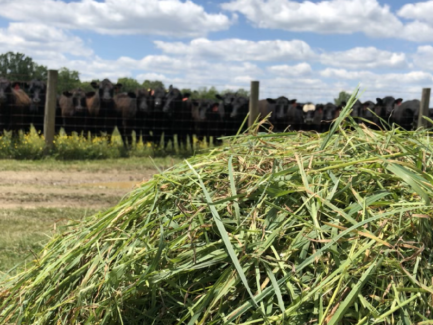

Dr. Gary Bates
Director and Professor
UT Beef & Forage Center
P: 865-974-7324
I have received several phone call and emails over the last month that have all had a similar question. They had been forced to delay hay cutting for some reason and were wondering if it was too late to cut the hay. They wanted to know if the hay was worth cutting, or should they just mow it down and let the plants regrow. In each case they had tall fescue that was 6-8 weeks past normal hay cutting stage.
This is often a difficult question to answer. Part of the answer deals with what the quality of the hay will be. Research shows that once these plants produce a seedhead, the protein and energy level slowly begin to drop. After 6 weeks or so, the protein level will have dropped from 12-15 percent down to 6-8 percent. It will be easy to determine this by taking a sample and having a forage test run. This will measure the forage quality, telling you the level of protein, energy, fiber, and other constituents.
The more difficult part is know if it is worth it for you to cut and bale. I usually hate to see anyone waste forage, but if you consider what diesel, time, and equipment wear and tear costs, there may be times it is better to buy hay than spend money producing the hay just to have to turn around and supplement it because the quality is so poor.
Where that point is might differ between various producers. If we know that cows need at least 10 percent protein during the winter, hay testing 8 percent might not be worth the effort for some producers. They may not want to add the expense of supplementing with a protein and energy feed. Some producers might be better able to feed a supplement, and they can use the lower quality hay successfully.
So now you are probably thinking “Thanks, Bates. You have proceeded to avoid answering the question.” There are really three things I want you to get from this article.
- Figure out how much it costs you to produce hay. You need to know how much it costs you to produce each ton of hay. That will provide you information to know whether you should keep producing hay, or maybe switch to purchasing all your hay. This might remove the stress of trying to fight the weather each spring.
- Cut you hay as early as possible. Don’t be late cutting your hay, because the nutrient content drops after the grass produces a seedhead. If you are going to go to the trouble and expense of making hay, then make good quality hay. I have never seen anyone have a problem with their hay being too high in nutrients. I have seen problems with the reverse.
- Forage test your hay. Whether you cut your hay on time or a little late, always take a sample and submit it to the University of Tennessee Soil, Plant, and Pest Center for an analysis. You can learn the level of nutrients in the hay, which can help you determine if the hay is good enough by itself, or if it will need supplementation to meet a cow’s nutrient requirements. You can contact your local Extension office about the specifics of taking and submitting a sample.
Just like with many things in life, what seems to be a simple question has a very difficult and complex answer. But getting information is the key to determining the correct answer.